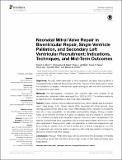| dc.contributor.author | Myers, Patrick O. | en_US |
| dc.contributor.author | Baird, Christopher W. | en_US |
| dc.contributor.author | del Nido, Pedro J. | en_US |
| dc.contributor.author | Pigula, Frank A. | en_US |
| dc.contributor.author | Lang, Nora | en_US |
| dc.contributor.author | Marx, Gerald R. | en_US |
| dc.contributor.author | Emani, Sitaram M. | en_US |
| dc.date.accessioned | 2015-12-04T18:13:33Z | |
| dc.date.issued | 2015 | en_US |
| dc.identifier.citation | Myers, Patrick O., Christopher W. Baird, Pedro J. del Nido, Frank A. Pigula, Nora Lang, Gerald R. Marx, and Sitaram M. Emani. 2015. “Neonatal Mitral Valve Repair in Biventricular Repair, Single Ventricle Palliation, and Secondary Left Ventricular Recruitment: Indications, Techniques, and Mid-Term Outcomes.” Frontiers in Surgery 2 (1): 59. doi:10.3389/fsurg.2015.00059. http://dx.doi.org/10.3389/fsurg.2015.00059. | en |
| dc.identifier.issn | 2296-875X | en |
| dc.identifier.uri | http://nrs.harvard.edu/urn-3:HUL.InstRepos:23845208 | |
| dc.description.abstract | Objectives: Although mitral valve repair is rarely required in neonates, this population is considered to be at high risk for adverse outcomes. The aim of this study was to review the indications for surgery, mechanisms, repair techniques, and mid-term outcomes of neonatal mitral valve repair. Methods: The demographic, procedural, and outcome data were obtained for all neonates who underwent mitral valve repair from 2005 to 2012. The primary endpoints included mortality, transplantation, and mitral valve reoperation. Results: Twenty patients were included during the study period. Median age at operation was 11 days (range: 3–25). Eleven patients (55%) presented with mitral stenosis, three had regurgitation (15%), and six had mixed mitral disease (30%). Nineteen of 20 patients had mild or less regurgitation on immediate postoperative imaging. During a median follow-up of 5 months (1 month–4.8 years), six patients died at a median of 33 months (7–41 months) from repair and one patient required orthotopic heart transplantation. Six patients required mitral valve reoperation, five for mitral valve re-repair, and one for mitral valve replacement. Freedom from death, transplantation, or mitral valve replacement was 84.2 ± 8.4% at 1 month, 71.3 ± 11% at 6 months, 64.1 ± 12% at 1 year, and 51.3 ± 15% at 2 years and was worse for patients presenting with mitral regurgitation compared to stenosis or mixed mitral valve disease. Conclusion: Although mitral valve repair can be performed with acceptable immediate postoperative result, this procedure carries a high burden of late death and mitral valve reoperations. | en |
| dc.language.iso | en_US | en |
| dc.publisher | Frontiers Media S.A. | en |
| dc.relation.isversionof | doi:10.3389/fsurg.2015.00059 | en |
| dc.relation.hasversion | http://www.ncbi.nlm.nih.gov/pmc/articles/PMC4639623/pdf/ | en |
| dash.license | LAA | en_US |
| dc.subject | mitral valve | en |
| dc.subject | mitral valve repair | en |
| dc.subject | neonatal | en |
| dc.subject | congenital heart disease | en |
| dc.subject | surgery | en |
| dc.title | Neonatal Mitral Valve Repair in Biventricular Repair, Single Ventricle Palliation, and Secondary Left Ventricular Recruitment: Indications, Techniques, and Mid-Term Outcomes | en |
| dc.type | Journal Article | en_US |
| dc.description.version | Version of Record | en |
| dc.relation.journal | Frontiers in Surgery | en |
| dash.depositing.author | Baird, Christopher W. | en_US |
| dc.date.available | 2015-12-04T18:13:33Z | |
| dc.identifier.doi | 10.3389/fsurg.2015.00059 | * |
| dash.contributor.affiliated | Baird, Christopher | |
| dash.contributor.affiliated | Marx, Gerald | |
| dash.contributor.affiliated | Emani, Sitaram | |
| dash.contributor.affiliated | Del Nido, Pedro | |
| dash.contributor.affiliated | Pigula, Frank A. | |


